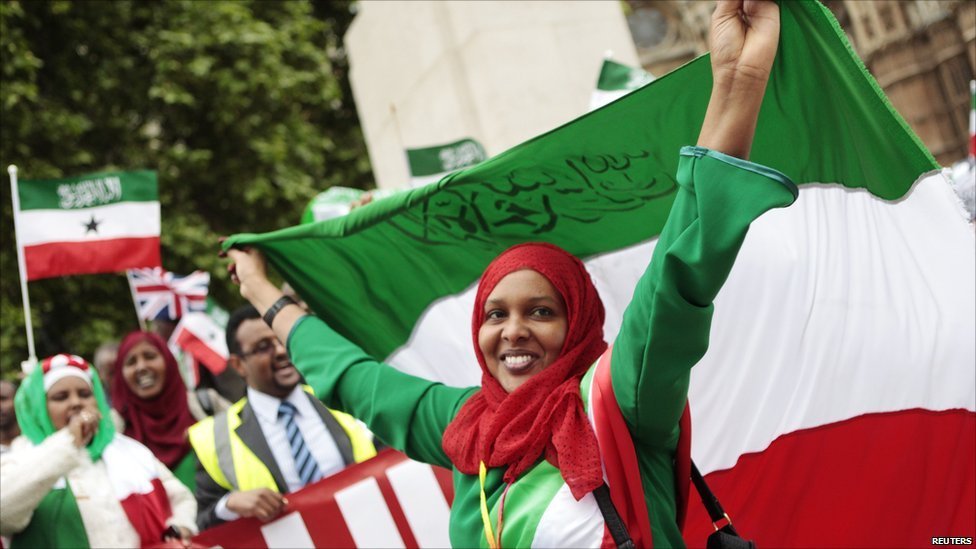

With Somaliland’s Independence Day less two days away, ordinary Somalilanders painted their shops, cars, and private offices with the nation’s tri-colored flag. In the wake of the continuous suicide jihad bombing in Somalia’s capital Mogadishu, Hargeisa’s security is beefed up to avert the possible disruptions by Islamist unionists who consider the day, a dark day of Somalia’s balkanization. Somaliland’s government detained MP Saleban Ali Koore who questioned the relevance of the day while he was proposing emphasis on the 26th of June, 1960 when Great Britain gave independence to Somaliland.
Although the day coincided the Ramadan, there is a silent preparation of the 18th of May. This day has constitutional ambiguity, according to lawyers, it’s not clearly defined as the national Independence Day but “victory day” over Somalia’s army and its eviction from Somaliland’s territory. No doubt, regardless of the ongoing debate of whether the 26th of June or that day is the independence day, the 18th of May is the most important day of all and widely celebrated annually throughout the nation. Both tribes allied with Somalia’s fallen military regime and the freedom fighter ones firmly commemorate the day because all share the loyalty of the flag. Many nationals will wear clothes in the flag’s three colors: red, white, and green. Voluptuous girls will mark the day by painting their delicate cheeks with the flags and wave mini-flags during the president’s speech. Firecrackers are often heard overnight.
The declaration of the day as Somaliland’s restoration of the lost independence due to the merger with the ill-fated union with Mogadishu created unnecessary controversy. It’s martyrs day too. Thousands of freedom fighters were killed in the name of this day; the government nor the people can tolerate any mockery of this historic day.
After tomorrow, his Excellency President Muse Bihi Abdi will address to the nation in temporary podium next to the Hargaysa’s Group Hospital, so for sure, the patients in agony will listen willy-nilly. A military parade will follow, and the flag is hoisted, and military salute is given to the president.
How Somaliland gained de facto independence?
In 1991, following the shameful fall of the central government in Mogadishu, political figures, as well as chiefs of tribes from all over Somaliland, met in Burcoa, the second largest city in the country to make self-determination fully enshrined in the UN laws and restore their independence and reinvent the borders Britain left when it gave independence to Somaliland.
The signatory tribes are below:
1. Harti tribe (excluding Majeerten.)
2. Samaroon
3. Isse
4. Guddabiirsi
5. Gabooye
6. Madigan
7. Isaq
8. Other minorities
The rest of the tribes will severely punish any tribe that violates Somaliland’s constitution in any form or way.
The signers reaped the rewards by avoiding Somalia’s bloodbath. The region has been stable for most of its existence.
Of the prevailing economic and political stability amid the absence of recognition, the international investors dared to establish business outlets, for example, Co-Cola company and DHL both operate in Somaliland. DP world also operates the Berbera port.
Somaliland next door to Somalia plagued by Jihad and suicide bombing is keeping piracy and directionless Jihad out of its borders. Minister of Religion Khalil began registration of Madrasa staff and unifying its curricula with the country’s one. The registration is hailed as a step forward in a country where of whatsoever sold in the name of the religion was insulated from investigation and scrutiny.
However; some countries with little knowledge about Somalia’s current reality view Somaliland a part of Somalia because of the namesake. Somalilanders to drop the name to avoid confusion but for historical reasons, others claim to keep it but clarify the difference between pirate-and-Jihadi Somalia and a democratic Somaliland whose presidential election is held like other democracies in every four or eight years.
Abdirahman Dirie: is a Somaliland Activist and freelance Writer and Journalist. Hargeisa
The ideas, conclusions and recommendations of an opinion article in Somaliland.com are solely those of its author(s), and do not reflect the views of the Institution, its management, or its other scholars.
more recommended stories
 Somaliland to Defend Sovereignty Against Somalia’s Provocative Laascaanood Visit
Somaliland to Defend Sovereignty Against Somalia’s Provocative Laascaanood VisitThe Ministry of Foreign Affairs and.
 New Director Appointed: Burao Hospital’s Fall and the Fight for Revival
New Director Appointed: Burao Hospital’s Fall and the Fight for RevivalBurao Hospital begins a new chapter.
 Somaliland: While Mogadishu Burns, Somalia Seeks Chaos in Sool
Somaliland: While Mogadishu Burns, Somalia Seeks Chaos in SoolHargeisa, April 9, 2025 – (Somaliland.com).
 Somaliland Presidency Delivers 10 Vital Dialysis Machines to Hargeisa Group Hospital
Somaliland Presidency Delivers 10 Vital Dialysis Machines to Hargeisa Group HospitalHargeisa – Somaliland – The President.

